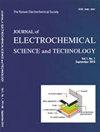PEO基复合电解质对全固态锂硫电池的降解
IF 3
4区 工程技术
Q3 ELECTROCHEMISTRY
Journal of electrochemical science and technology
Pub Date : 2021-12-07
DOI:10.33961/jecst.2021.00864
引用次数: 3
摘要
锂硫电池(LSB)由于其高能量密度和经济可行性,已成为锂离子电池(LIBs)的一种有前途的替代品。此外,使用固态电解质的全固态LSB已被提出,以克服多硫化物穿梭效应,同时提高安全性。然而,电极和固态电解质分别表现出的高界面电阻和较差的离子导电性是这些LSB开发中的重大挑战。在此,我们应用聚环氧乙烷(PEO)基复合固态电解质与全固态LSB中的氧化物Li7La3Zr2O12(LLZO)固态电解质来克服这些挑战。我们使用电化学方法根据阴极内的碳含量和负载重量来评估全固态LSB的降解。硫碳含量为3:3的全固态LSB表现出高的初始放电容量(1386mAh g-1)、较差的C倍率性能和小于50%的容量保持率。具有高负载重量的全固态LSB表现出较差的整体电化学性能。通过系统分析揭示了影响电化学性能下降的因素。7La3Zr2O12(LLZO)、聚环氧乙烷(PEO)本文章由计算机程序翻译,如有差异,请以英文原文为准。
Degradation of All-Solid-State Lithium-Sulfur Batteries with PEO-Based Composite Electrolyte
Lithium-sulfur batteries (LSBs) have emerged as a promising alternative to lithium-ion batteries (LIBs) owing to their high energy density and economic viability. In addition, all-solid-state LSBs, which use solid-state electrolytes, have been pro-posed to overcome the polysulfide shuttle effect while improving safety. However, the high interfacial resistance and poor ionic conductivity exhibited by the electrode and solid-state electrolytes, respectively, are significant challenges in the development of these LSBs. Herein, we apply a poly (ethylene oxide) (PEO)-based composite solid-state electrolyte with oxide Li 7 La 3 Zr 2 O 12 (LLZO) solid-state electrolyte in an all-solid-state LSB to overcome these challenges. We use an electrochemical method to evaluate the degradation of the all-solid-state LSB in accordance with the carbon content and loading weight within the cathode. The all-solid-state LSB, with sulfur-carbon content in a ratio of 3:3, exhibited a high initial discharge capacity (1386 mAh g -1 ), poor C-rate performance, and capacity retention of less than 50%. The all-solid-state LSB with a high loading weight exhibited a poor overall electrochemical performance. The factors influencing the electrochemical performance degradation were revealed through systematic analysis. 7 La 3 Zr 2 O 12 (LLZO), Poly(Ethylene Oxide) (PEO)
求助全文
通过发布文献求助,成功后即可免费获取论文全文。
去求助
来源期刊

Journal of electrochemical science and technology
ELECTROCHEMISTRY-
CiteScore
6.30
自引率
8.10%
发文量
44
期刊介绍:
Covering fields:
- Batteries and Energy Storage
- Biological Electrochemistry
- Corrosion Science and Technology
- Electroanalytical Chemistry and Sensor Technology
- Electrocatalysis
- Electrochemical Capacitors & Supercapcitors
- Electrochemical Engineering
- Electrodeposition and Surface Treatment
- Environmental Science and Technology
- Fuel Cells
- Material Electrochemistry
- Molecular Electrochemistry and Organic Electrochemistry
- Physical Electrochemistry
- Solar Energy Conversion and Photoelectrochemistry
 求助内容:
求助内容: 应助结果提醒方式:
应助结果提醒方式:


